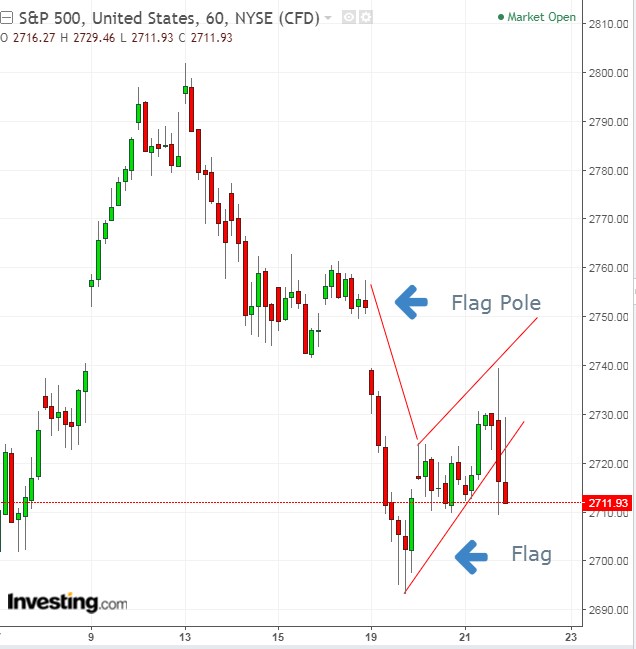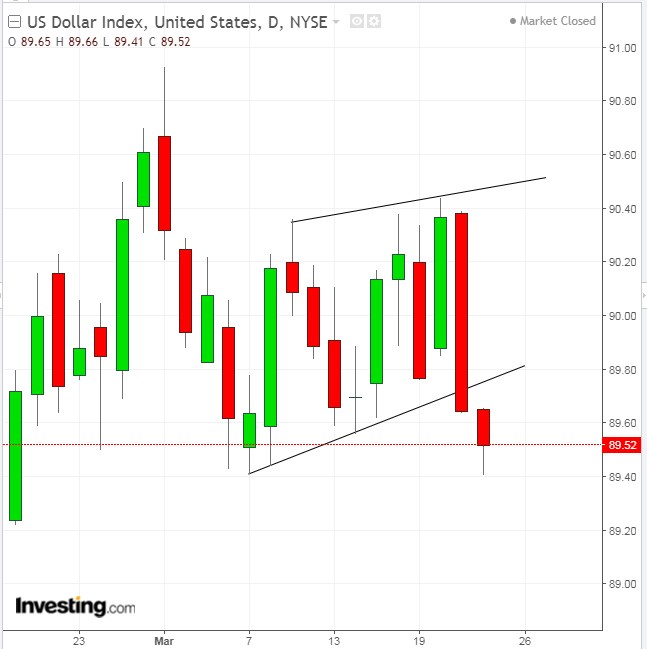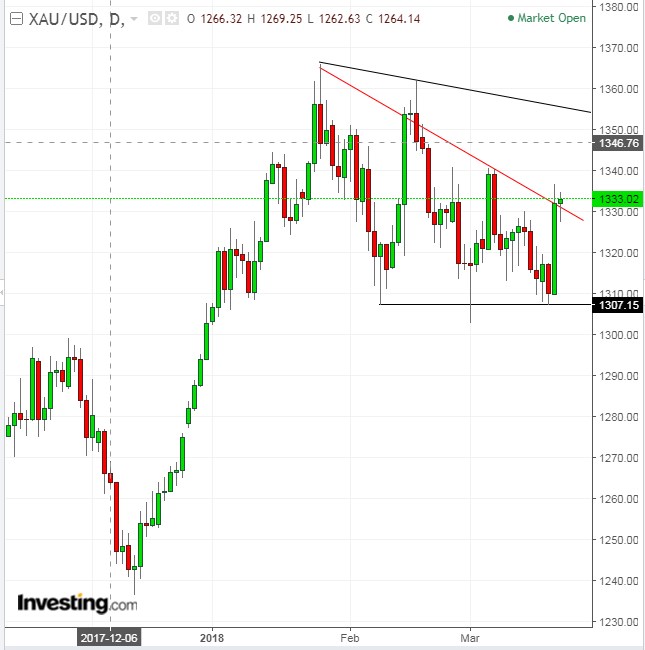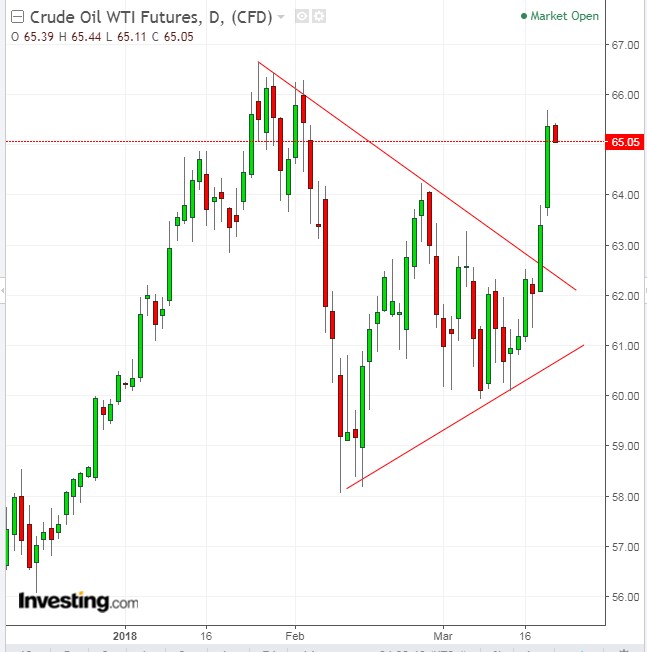-
Dollar losses grow; yen strongest G-10 currency
-
Global stocks extend declines, US markets poised to resume selling
-
Investors whipsawed to higher interest rates
-
Oil slips after jump on surprise drawdown and Middle East tensions
Key Events
The dollar remains weak after a volatile Asian session and Treasury yields extended their decline this morning. European stocks are slding along with S&P 500, Dow and NASDAQ futures.
The STOXX Europe 600 dropped for a second day, weighed down mainly by bank shares, which took a beating on the outlook for diminished profits after yesterday's Fed interest rate decision. US policymakers hiked benchmark rates by a quarter percentage point on Wednesday and forecast a more aggressive path to tightening for 2019 and 2020.
Asian stocks were volatile as traders remained indecisive about whether the quarter-point rate increase in the US will help or hinder the economy. Lurking in the background, and also weighing on investors' minds, was the possibility that US President Donald Trump' will shortly authorize a $50 billion trade tariff on Chinese imports.
Japanese equities listed on the TOPIX pushed higher after the yen retreated from its daily high. South Korea's KOSPI reached its highest level since early February, but was weighed down by a strengthening won.
The South Korean currency was buoyed by the Fed's less-hawkish-than-expected stance, resulting in a High Wave candle, which occurs when prices swing up and down but settle with little changed. The development of this trading pattern at the top of the March range increases the likelihood of a reversal.
Meanwhile, Chinese investors dumped shares after the People's Bank of China raised short term market rates by 5 basis points, to 2.55. These rates influence reverse repurchase agreements (known as repos), used for open market operations.
Global Financial Affairs
Today's widespread volatility appears to mirror the dynamic seen yesterday across US indices, which initially gained ground but ended by closing lower.
The Russell 2000 outperformed its major index peers, climbing over half percent point. The domestic exposure of its smaller-cap stocks means they would be broadly unaffected by a trade war.

Trading of the S&P 500 formed an hourly bearish Rising Flag. The obvious difference between US and Asian investors is that US bulls turned bearish after the Fed announcement, while Asian market players already had all that information priced in.
However, one element is consistent across the board: equity traders keep changing their views on the actual implications of higher interest rates. When stocks starting selling off in late January, the event was prompted by yields on 10-year Treasurys surging to a 4-year high, underscoring higher rates. However, the February rebound—which marked the strongest bounce back in years—seemed to be an acceptance of the new reality of economic growth, indicating confidence that the healthy economic backdrop would counterbalance the effects of higher rates.
This, in turn, was followed by a second equity selloff, driven by new Fed Chair Jerome Powell signaling that a faster pace of tightening was on the cards. But then, stocks climbed again, despite an increased outlook for four rate hikes in 2018 and the cumbersome prospect of a looming trade war.
Yesterday, after Powell indicated only three rate hikes for this year, stocks slipped again. Oddly, a weaker dollar should have helped drive equities higher, on added profits for exporters. But yesterday, the greenback's weakness only served to remind investors of the specter of a trade war.
Either way, these inconsistent reactions to the very same fundamental of rising interest rates seems to be leading the SPX to form a top, clearly visible in its bearish Rising Wedge.

It may seem counterintuitive that the dollar would fall after a rate hike. The selloff was ignited by dollar bulls starting to price in a fourth hike this year, following Powell's bullish statement on February 27, which was read as a move in that direction. However, after the Fed went mum yesterday on a potential fourth hike, disappointed bulls closed long positions.
The same disappointment led to a Treasury selloff, as, based on the reduced rate outlook, bonds suddenly looked overpriced.
The yen proved to be the strongest G-10 currency, boosting Asian emerging market currencies. As interest-rate differentials ceased to play a role in trader decision making, they bought back into the Japanese currency's safe haven status. Falling Treasurys jibe with that assessment, as traders increase their bond holdings.
Gold levels confirmed a picture of general risk-off, as prices jumped 1.65 percent, the largest gain since August 28, when North Korea fired a missile over Japan. At that time, gold broke $1,300.

Technically, the price of gold bounced on the support of a potential Descending Channel and found resistance at potential top of the range. This pattern demonstrates an ever-increasing supply—highlighted by an encroaching supply line, the falling range top—while demand stagnates—underscored by a flat demand line, the range bottom.

WTI seems to be partly retracing yesterday's gains. Prices jumped more than three-percent to a 7-week high, thanks to a surprise 2.6-million-barrel draw in crude inventories against analyst expectations of a supply increase of 2.5 million barrels.
Speculators were quick to rebalance the price of oil, based on the cheaper dollar. Yesterday, oil prices were also propelled by mounting political tensions between Saudi Arabia and Iran, with the Saudis threatening to enter a nuclear arms race as a way to persuade President Donald Trump to renew economic sanctions which would affect Iranian oil.
Up Ahead
-
The Bank of England is expected to keep interest rates and its asset-purchase program unchanged on Thursday. Attention will be on language and the odds for a May hike, now seen as increasingly likely.
-
Euro area flash PMIs are out Thursday as well as Germany’s IFO gauge of business confidence.
- Dropbox"s (NASDAQ:DBX) much-anticipated IPO is scheduled for tomorrow. The price range expectation for the IPO was raised by $2 yesterday to $18-$20 per share. Final numbers won't be confirmed till later today.
Market Moves
Stocks
-
The STOXX Europe 600 Index sank 0.6 to the lowest in more than two weeks.
-
The MSCI World Index of developed countries gained 0.2 percent, the largest rise in more than a week.
-
The MSCI Asia Pacific Index gained 0.3 percent, the first advance in a week.
-
The Shanghai Composite Index decreased 0.5 percent to the lowest level in more than two weeks.
-
S&P 500 Futures sank 0.5 percent to 2,703.50, the lowest level in almost three weeks.
Currencies
-
The Dollar index extended a decline 0.15 percent after yesterday's 0.8 percent fall, to 89.52, its lowest two weeks. Technically, it broke out of trading range in the same period.
-
The euro rose 0.3 percent to the strongest in more than a week.
-
The British pound gained 0.2 percent to the strongest in seven weeks.
-
The Japanese yen climbed 0.4 percent to 105.65 per dollar, the strongest in more than 16 months.
Bonds
-
The yield on 10-year Treasuries decreased three basis points to 2.85 percent, the biggest dip in three weeks.
-
Germany’s 10-year yield fell two basis points to 0.57 percent, the lowest in almost two months.
Commodities
- WTI declined less than 0.05 percent to $65.16 a barrel.
- Gold gained 0.1 percent to $1,333.09 an ounce, the highest in more than two weeks.
